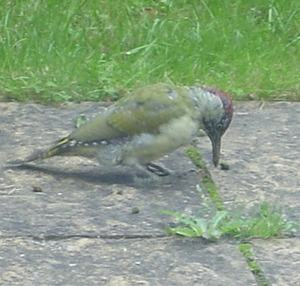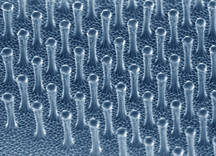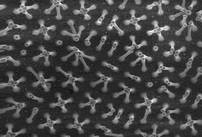Studying the effects of habitat fragmentation on diversity of wildlife...
In the hearts of forests and jungles around the world there exist members of a feral strain of scientist who grew up on a steady diet of the Captain Planet cartoons.
 They’ve
swapped lab coats for khaki shirts, plastic shoe covers for walking
boots, and safety goggles for binoculars in order to study and help
protect the creatures surviving in the most biodiverse, but threatened,
habitats in the world. Rumours of spandex-wearing are entirely unfounded
though.In between the Amazon basin, the hot eastern Brazilian savannahs
and the temperate grasslands of Argentina lies the Atlantic Forest. It
is home to a diversity of plants and animals to rival that of the famous
Amazon Rainforest itself, including a number of species found nowhere
else such as the golden lion tamarin, the maned three-toed sloth, and
the woolly spider monkey. The forest once stretched along one third of
the coast of South America, inland as far as Paraguay. However, today
the Atlantic Forest has the dubious status of being one of the most
devastated habitats in the world. Shockingly, just 7% remains. What
makes this statistic even worse is that the forest consists not of one
continuous stretch of woodland but instead thousands of small fragments
separated by huge crop and cattle farms.Deforestation of the Atlantic Forest, like in many places around
the world, has had a directly detrimental effect on many species of
animals by destroying their habitats. However, in all of these
ecosystems across the world the wildlife that remains – even in
pristine, untouched habitat – are under threat due to the effects of
fragmentation.Habitat fragmentation spells very bad news for wildlife for many
reasons. Firstly, small fragments don’t have the volume of fruit and
other vegetation to support complex ecosystems. Low volumes of fruit and
vegetation means few plant matter-eating animals, and even fewer large
animals that prey on them. Secondly, large animals require not just
large territories but also access to the territories of other
populations of their species. This helps to avoid inbreeding and instead
maintain a healthy level of genetic diversity. Unfortunately for many
species of land animal, a fragment half a mile away on the other side of
a cattle farm may as well be on the other side of the world.Finally, fragmentation means that more of the habitat is
bordering against agricultural land. This degrades the quality of the
habitat along its edges because farming has an effect on the soil,
amount of shade and the temperature. This ‘Edge Effect’ is revealed in
poor tree growth and the absence of many animal species up to 100 metres
in from the forest edge. Additionally, more bordering against human
land means more encroachment by hunters and by agricultural development,
so fragments get replaced by crop fields and cattle ranches much faster
than large areas do – it’s like the way a teaspoon of sugar into your
tea dissolves faster than a sugar cube.There are lots of reasons that biologists may find themselves
working in a jungle, savannah or swamp, other than wishing they were
Steve Irwin. But one of the key concerns of ecology and conservation
biologists is to document what level of biodiversity – that is, the
variety of different animal and plant species – that an area can
support. Biodiversity is an important indicator of how healthy an
ecosystem is – decreases can reflect the detrimental effects of
deforestation, disease or hunting, and increases can reflect progress of
efforts to protect habitats. For example, biodiversity may be lower,
i.e. there are fewer different species, in a small fragment of the
Atlantic Forest compared to a much larger fragment. Often it is the
biggest species that are absent in small habitat fragments – hefty
grazing mammals that need a lot of land and vegetation like elephants,
giraffes or tapir, or large animals at the top of their food chain like
jaguars, caiman or anaconda. However, small animals are also vulnerable,
especially if they have very specific dietary or shelter needs. Indeed,
many of the most endangered species in the world are small animals that
live a fragile existence.Assessing biodiversity starts with trying to work out how many
species there are in an area, and estimating how many individuals there
are of each species based on how many you find. Unluckily for scientists
and ecotourists alike, habitats are rarely like safari parks, where
animals are pretty much always visible and easy to observe. Biologists
and conservationists don’t lament this fact though –wildlife’s fear of
humans is ideal for avoiding hunters. But between animals being rare,
well-hidden, fast, living in impenetrable habitat such as thick forest,
or spread over a huge area, it can be difficult or even impossible to
find a species. That’s why assessing a location’s biodiversity uses a
wide range of different scientific techniques. These techniques range
from a very simple bucket dug into the ground, to complex DNA analysis
techniques in the lab. The technique you use depends on the kind of
habitat you are assessing and the kind of animals you’re looking for.The most basic method is to simply walk through a habitat and
keep your eyes and ears open for the animals themselves or signs of
them. This works for conspicuous, noisy animals such as apes, or birds
with identifiable nests, or creatures with predictable hiding habits
such as some snakes
They’ve
swapped lab coats for khaki shirts, plastic shoe covers for walking
boots, and safety goggles for binoculars in order to study and help
protect the creatures surviving in the most biodiverse, but threatened,
habitats in the world. Rumours of spandex-wearing are entirely unfounded
though.In between the Amazon basin, the hot eastern Brazilian savannahs
and the temperate grasslands of Argentina lies the Atlantic Forest. It
is home to a diversity of plants and animals to rival that of the famous
Amazon Rainforest itself, including a number of species found nowhere
else such as the golden lion tamarin, the maned three-toed sloth, and
the woolly spider monkey. The forest once stretched along one third of
the coast of South America, inland as far as Paraguay. However, today
the Atlantic Forest has the dubious status of being one of the most
devastated habitats in the world. Shockingly, just 7% remains. What
makes this statistic even worse is that the forest consists not of one
continuous stretch of woodland but instead thousands of small fragments
separated by huge crop and cattle farms.Deforestation of the Atlantic Forest, like in many places around
the world, has had a directly detrimental effect on many species of
animals by destroying their habitats. However, in all of these
ecosystems across the world the wildlife that remains – even in
pristine, untouched habitat – are under threat due to the effects of
fragmentation.Habitat fragmentation spells very bad news for wildlife for many
reasons. Firstly, small fragments don’t have the volume of fruit and
other vegetation to support complex ecosystems. Low volumes of fruit and
vegetation means few plant matter-eating animals, and even fewer large
animals that prey on them. Secondly, large animals require not just
large territories but also access to the territories of other
populations of their species. This helps to avoid inbreeding and instead
maintain a healthy level of genetic diversity. Unfortunately for many
species of land animal, a fragment half a mile away on the other side of
a cattle farm may as well be on the other side of the world.Finally, fragmentation means that more of the habitat is
bordering against agricultural land. This degrades the quality of the
habitat along its edges because farming has an effect on the soil,
amount of shade and the temperature. This ‘Edge Effect’ is revealed in
poor tree growth and the absence of many animal species up to 100 metres
in from the forest edge. Additionally, more bordering against human
land means more encroachment by hunters and by agricultural development,
so fragments get replaced by crop fields and cattle ranches much faster
than large areas do – it’s like the way a teaspoon of sugar into your
tea dissolves faster than a sugar cube.There are lots of reasons that biologists may find themselves
working in a jungle, savannah or swamp, other than wishing they were
Steve Irwin. But one of the key concerns of ecology and conservation
biologists is to document what level of biodiversity – that is, the
variety of different animal and plant species – that an area can
support. Biodiversity is an important indicator of how healthy an
ecosystem is – decreases can reflect the detrimental effects of
deforestation, disease or hunting, and increases can reflect progress of
efforts to protect habitats. For example, biodiversity may be lower,
i.e. there are fewer different species, in a small fragment of the
Atlantic Forest compared to a much larger fragment. Often it is the
biggest species that are absent in small habitat fragments – hefty
grazing mammals that need a lot of land and vegetation like elephants,
giraffes or tapir, or large animals at the top of their food chain like
jaguars, caiman or anaconda. However, small animals are also vulnerable,
especially if they have very specific dietary or shelter needs. Indeed,
many of the most endangered species in the world are small animals that
live a fragile existence.Assessing biodiversity starts with trying to work out how many
species there are in an area, and estimating how many individuals there
are of each species based on how many you find. Unluckily for scientists
and ecotourists alike, habitats are rarely like safari parks, where
animals are pretty much always visible and easy to observe. Biologists
and conservationists don’t lament this fact though –wildlife’s fear of
humans is ideal for avoiding hunters. But between animals being rare,
well-hidden, fast, living in impenetrable habitat such as thick forest,
or spread over a huge area, it can be difficult or even impossible to
find a species. That’s why assessing a location’s biodiversity uses a
wide range of different scientific techniques. These techniques range
from a very simple bucket dug into the ground, to complex DNA analysis
techniques in the lab. The technique you use depends on the kind of
habitat you are assessing and the kind of animals you’re looking for.The most basic method is to simply walk through a habitat and
keep your eyes and ears open for the animals themselves or signs of
them. This works for conspicuous, noisy animals such as apes, or birds
with identifiable nests, or creatures with predictable hiding habits
such as some snakes  Despite being simple, this technique does need careful consideration – timing and location are everything.
Despite being simple, this technique does need careful consideration – timing and location are everything.
Trapping methods are useful for a wide range of different animals that are harder to spot. Small, ground-dwelling animals such as rodents, scorpions, tarantulas, flightless insects, frogs, lizards and small snakes can all be assessed with drift fences and pitfall traps: they bump into a temporary fence (usually a long sheet of plastic) and in trying to get around it fall into buckets dug into the ground. With a layer of soil and shelter at the bottom, these buckets house the animals until they can be checked, recorded and released. Bigger, trigger-mechanism traps can be used to trap mammals and lizards of various sizes, often using bait to entice them in. Bats and low-flying birds can be trapped using fine nets called mist nets.For spotting cautious and elusive animals, such as jaguar or snow leopards, a camera trap is a wonderful piece of equipment. A weather-proof camera with a motion sensor can be strapped to a tree trunk or rock and left for days or sometimes weeks to digitally capture any animal that happens to pass by. They can be expensive, but they’re worth it: camera traps often provide the only picture or video of a species in an area.For those animals that can be caught, small microchips can be swiftly injected under the skin so it can be identified if caught again – calculating how many captures are actually ‘recaptures’ provides an estimate of how many of that species there are in total. For those animals that are elusive and more difficult to trap, camera traps are great for determining the presence of that species but are unlikely to be able to provide a good estimate of the number of individuals in a population.This is where laboratory science comes back into the picture. Genetic analysis is now one of the most useful and widespread tools in conservation science – and usually involves poo! Faeces give us a whole host of information – not only can it help to identify the diet and diseases of a species, the DNA of the ‘donor’ can be extracted and amplified in order to determine the individual’s identity, gender and family heritage. Obtaining the genetic code of just a few individuals can provide enough information to estimate the population number and determine the level of genetic diversity.In short, both field and lab techniques combine to help us determine if an ecosystem fragment is large enough, and has sufficient access to other fragments, to maintain healthy populations of its resident species. With this information, conservationists can go about providing these animals with what they need in order to survive well into the future. In fact, Captain Planet probably did some of his best work in a lab coat...


 Still,
the most dramatic change these wetlands are undergoing is the
inundation of saltwater and the loss of land. Since the early 1930s, it
is estimated that Louisiana has lost almost 5,000 square kilometers of
wetlands. In fact, some say an area the size of a
Still,
the most dramatic change these wetlands are undergoing is the
inundation of saltwater and the loss of land. Since the early 1930s, it
is estimated that Louisiana has lost almost 5,000 square kilometers of
wetlands. In fact, some say an area the size of a 

 But
while many people have been working on ways to treat diseases by
correcting the function of affected proteins, my research looks at the
fundamental question of how proteins fold when they are working
properly. If we want to understand complicated diseases, we first need
to understand how things work normally. A lot of the questions I’m
asking are just the same as those you might ask about the pop-up book.
What does the folded protein look like? What does the unfolded one look
like? Is there a preferred order or logic to the self-assembly?
But
while many people have been working on ways to treat diseases by
correcting the function of affected proteins, my research looks at the
fundamental question of how proteins fold when they are working
properly. If we want to understand complicated diseases, we first need
to understand how things work normally. A lot of the questions I’m
asking are just the same as those you might ask about the pop-up book.
What does the folded protein look like? What does the unfolded one look
like? Is there a preferred order or logic to the self-assembly?



 Firstly,
woodpeckers have relatively small brains which, in contrast to a human,
are packed fairly tightly inside their skull cavity. This prevents the
excessive movement of the brain inside the skull, which causes so-called
'contre-coup' injuries in humans. These occur when the brain bashes
into the skull following a knock on the head. In other words the head
stops, but the brain keeps on moving momentarily afterwards.
Firstly,
woodpeckers have relatively small brains which, in contrast to a human,
are packed fairly tightly inside their skull cavity. This prevents the
excessive movement of the brain inside the skull, which causes so-called
'contre-coup' injuries in humans. These occur when the brain bashes
into the skull following a knock on the head. In other words the head
stops, but the brain keeps on moving momentarily afterwards. The
team found a tame acorn woodpecker, which could be encouraged to
perform for their camera by bashing out a few words on an old
typewriter. They watched as the bird first took aim and delivered a
number of "test taps" before unleashing a salvo of strikes, but always
in a dead straight line.
The
team found a tame acorn woodpecker, which could be encouraged to
perform for their camera by bashing out a few words on an old
typewriter. They watched as the bird first took aim and delivered a
number of "test taps" before unleashing a salvo of strikes, but always
in a dead straight line. 











 When
the CD4 count falls below a critical threshold (400 per microlitre of
blood) the body is no longer able to defend itself. At this point an
HIV-infected individual is said to have AIDS, and patients usually begin
to develop opportunistic infections caused by organisms that would not
normally affect healthy people. These include mycobaterial infections
(caused by bacteria related to tuberculosis), the lung infection PCP (pneumocystis carinii
pneumonia), oral and genital thrush, complications of CMV
(cytomegalovirus), chronic diarrhoea and weight loss,
toxoplasmosis, meningitis, dementia, and polyomavirus (JC virus), which
is associated with a disease of the brain's white matter known as PML
(progressive multifocal leucoencephalopathy). At this point patients are
often prescribed prophylactic drugs to help ward off some of these
infections including co-trimoxazole, which can slow down the progression
of PCP.
When
the CD4 count falls below a critical threshold (400 per microlitre of
blood) the body is no longer able to defend itself. At this point an
HIV-infected individual is said to have AIDS, and patients usually begin
to develop opportunistic infections caused by organisms that would not
normally affect healthy people. These include mycobaterial infections
(caused by bacteria related to tuberculosis), the lung infection PCP (pneumocystis carinii
pneumonia), oral and genital thrush, complications of CMV
(cytomegalovirus), chronic diarrhoea and weight loss,
toxoplasmosis, meningitis, dementia, and polyomavirus (JC virus), which
is associated with a disease of the brain's white matter known as PML
(progressive multifocal leucoencephalopathy). At this point patients are
often prescribed prophylactic drugs to help ward off some of these
infections including co-trimoxazole, which can slow down the progression
of PCP.